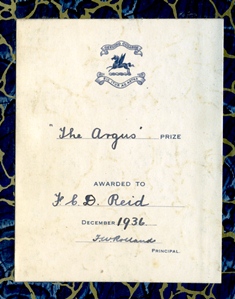REID, Frank Clarke-Dickson (1918-1945).JPG)
Frank Reid (Prefect 1936).
.jpg)
Frank Reid (War Service 1946)
Frank Clark Dickson Reid (1918-1945) was first enrolled at the College on 11 February 1931 after attending Randwick Preparatory School. He went on to become one of the most talented sportsmen at the College. He was in the 1st Football XVIII in 1934, 1935 and 1936; 1st Cricket XI 1934 and 1935; and its Captain in 1936. He was in the Athletics Team every year he was at College from 1931 to 1936 which must be close to a record. He was a School Prefect in 1935 and Head Prefect in 1936. He left College in December 1936.
The College holds in its Heritage Collection a trophy won be F C D Reid in 1931. Reid would have won this trophy during his first year. It is the
E R Sparrow Cup and at that time was the Under 14 version of the Geelong College Cup, the penultimate College athletics award. The E R Sparrow Cup was awarded on a points basis as a result of four athletics events: 100 yds; 220 yds; High Jump; and Long Jump. Reid won the two running races, was 3rd in the High Jump and 2nd in the Long Jump.
He was also the recipient of the College
Argus Prize in 1936. This award appears to be similar to the
Dr Baxter Prize which was awarded for exercising a 'manly influence' in the School. As a role model award it was usually given to the Head Prefect and
Pegasus in 1936 commented that:
'though it is usual for the Captain of the School to receive the 'Argus' prize for the boy exercising the most manly influence, it is plain that this year's award to Frank Reid was not merely automatic, but truly merited.' Frank Reid was a member of a prominent Western District Family. His grandfather, James Armstrong Reid (1856-1937) had been born on Woodbourne Station, Meredith and had also been educated at Geelong College during the 1870s. There are several other prominent Reid sportsman of the late nineteenth century who were probably his relatives. Several of these were prominent Geelong Football Club (GFC) players.
Frank was bom on 15 January 1918 at Melbourne, the son of George Clarke-Dickson and his wife Ella Floris nee Browne of Murrumbeena. He had been working on his father's property 'Colona Station', near Fowler's Bay, South Australia, when he enlisted (No SX 9600) during World War II becoming a Lance Sergeant with the 8th Division Ammmution Sub-Park, Australian Army Service Corps (AASC).
The Australian War Memorial (AWM) photographic collection describes Reid's experience as a prisoner of the Japanese:
'He was one of over 2000 Allied prisoners of war held in the Sandakan POW camp in North Borneo, having been transferred there from Singapore as part of E Force. The 500 Australian and 500 British POW's who made up 'E' Force left Changi on 28 March 1943, on board the SS De Klerk
arriving at Berhala Island (adjacent to Sandakan Harbour) on 15 April 1943. The POWs were held there until 5 June, when they were taken by barge to Sandakan. The next day they were transferred to the 8 Mile Camp, which was about half a mile from the B Force compound.' Lance Sergeant Reid, aged 27, died as a prisoner of the Japanese on 20 June 1945. He is commemorated on the Labuan Memorial Panel 21 (Commonwealth War Graves Commission).

Bookplate
from Frank Reid's 'Argus' Prize, 1936.
The Labuan Memorial was primarily intended to commemorate the officers and men of the Australian Army and Air Force who died while prisoners of war in Borneo and the Philippines from 1942 to 1945 and during the 1945 operations for the recovery of Borneo, and who have no known grave. Subsequently it was found that a number of men belonging to the local forces of North Borneo, Sarawak and Brunei who were killed on war service also have no known grave, and they too are honoured here.
Men of the Royal Australian Navy who lost their lives in the south-western Pacific region, and have no grave but the sea, are commemorated on Plymouth Naval Memorial in England, along with many of their comrades of the Royal Navy and of other Commonwealth Naval Forces. Some of those whose names appear on the memorial are undoubtedly buried in unidentified graves in the Labuan cemetery.
His father,
George Clark-Dickson Reid (1892-1967) was also educated at Geelong College.
Sources: Pegasus December 1936 p8; 'Geelong Collegians at the Second World War and Subsequent Conflicts' compiled by J. Affleck. pp78-79 (citing The Pegasus; Australian War Memorial; Commonwealth War Graves Commission; Photo The Pegasus).